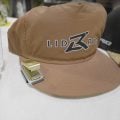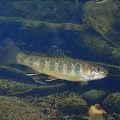Big Dry, Little Dry: Making the Set

Flies of diminishing size above the ever-finer tippets that suit them—normally suit them. Nothing in fly fishing is ever quite certain, fly-and-tippet combinations included. | photo by Carol Ann Morris
Question: “When a trout takes a large, say size 8, dry fly, do you set the hook that same as you’d set it for a much smaller size, say 20 or 22, dry fly?” – Will J
Answer: Before I address you and your fine question, Will (and I mean “fine” in both the sense of “excellent,” and the sense of “discriminate” as in “a fine distinction”), I’d better do a little explaining to my readers who are familiar with another dry-fly piece I wrote for this column: “Hooking Dry-Fly Trout.” That piece and this one, though related, are not the same. “Hooking” is about how long to pause before setting the hook after a trout takes your floating fly—it’s mainly about timing. This piece, the one you’re reading now, is mainly about how hard you set the hook on floating flies through a range of hook sizes. So, yes, both are on setting, but one’s on timing; the other, this one, is not about timing but mainly about how much force to apply.
So read on, readers, without fear that this is just the same business, disguised only by mild rearrangement, you’ve already seen me tackle in MidCurrent.
Will (and everyone else), I’ll start with a basic principle that’ll be our trailhead. From there we’ll walk together through my answer.
A Basic Principal of Hook Setting
It only makes sense to go ever finer on tippet as you go ever smaller on fly hooks. (Reminder: although this principal applies to all flies, we’re concerned only with floating flies here, right?) For a big beefy size 8 or 6 Stimulator, 3X tippet is a solid match. (New fly fishers: that’s a big trout dry fly and a tippet thick for trout fishing.) Equally solid is 4X tippet for a size 12 dry fly, 5X for size 14, 6X for sizes 20 and 22. The finer the tippet, the more easily it busts—so you can set much harder on 3X than on 6X. Conclusion: the larger the fly, the harder you can set the hook without breaking the tippet. There: Welcome to the basic principle of hook setting by fly size, and to the trailhead. Shall we stroll on?
That principle is valid, and in general does apply, but this, after all, is fly fishing: exceptions are to be expected. And here they are.
Reasonable Limits
Especially when you get into heavier tippets, it’s possible to set too hard yet not bust the tippet. The purpose of a hook set is to sink the hook’s point well into a fish—beyond that, you risk tearing the hook out if it has caught only a sliver of flesh on the trout’s jaw. But with a reasonable hook set and good fish-playing technique you might land a trout, even a big one, on that sliver.
A Practical Consideration
Dry flies are usually tied on fine-wire hooks, and these can be momentarily bent partway open on too hard a set. When a hook opens partway, that can be enough to free the trout. A fine-wire hook may open before the tippet it’s tied to snaps. Solution? Again: a set of sufficient force to sink the hook point and no more.
Another Practical Consideration
Tippet doesn’t always, shouldn’t always match hook size. Example: a size 8 mayfly dry fly that imitates well the big Western Green Drakes drifting down from a reach of quick current to ride the smooth water just below, where angler-savvy trout wait for them. Big fly, flat water—the nervous trout can see everything here well, and they have time to really look: only a fine tippet, say 5X, will pass their inspection. So, we have a combination of fine tippet and a big fly. Here, the tippet’s breaking point limits how hard you can set the hook—so set with extra care. Set even a smidge too hard and your tippet will fail.
Here’s the opposite scenario: The trout are big and strong, not especially cautious because they’re only lightly fished, and they’re on a hatch of size 20 caddisflies. So you go heavier on the tippet than you’d like, just to control your fish among all that submerged timber they can run to (and if you tie your own flies, you tie those floating caddis imitations not on light wire but on standard- or even heavy-wire hooks). Let’s say, 4X tippet. Now you can theoretically set harder than normal for a dinky size 20 floater. But the point of the heavy tippet here isn’t about hook setting, it’s about fish playing. So, sure, set a bit harder than usual for a size 20 to insure a good hook bite if you like, but don’t go wild: a solid sinking of the hook is all you need and you can’t get anything better than that. Then play that big, athletic trout with an extra dose of confidence thanks to your stout tippet.
Fast, Slow, or Somewhere in the Middle?
I’ve never felt that the size of my floating fly had anything to do with how soon I set the hook after a trout takes the fly, Will. I do vary my pauses between take and set, but that’s not about fly size. (It is, however, the subject of that MidCurrent piece I mentioned, “Hooking Dry-Fly Trout.”)
The Distance Factor
The farther away your fly is, the harder and quicker you must set in order to sink the hook—the difference in force and speed is slight, but real. Thing is, the more line between you and your fly, the more time you’ll need in order to set through the additional line slack and against the increased resistance that extra line will apply to your set. Seriously, though, this adjustment is easy to overdo.
How Light, How Hard?
So now you know to set more lightly on tiny flies than on middling-size ones, on middling-size ones more lightly than on big ones; more lightly on fine tippet than on heavy—but none of that truly tells you how firmly to set on any tippet or fly. Honestly, that’s a much easier thing to convey by showing than by telling. Still, I think I can pull it off.
I’ve been setting hooks on floating flies of all sizes since I was a kid, and that was now crazy long ago—the proper force on all hook sets is in my blood and bones. But to make sure I got the nuances right, I just worked with a rigged six-weight trout rod, practicing different hook sets with the tippet tied to the base of my guitar stand.
Here’s what I got: On a fly of size 18 or smaller, the set is a tad beyond just pulling until the line straightens—but it is more than just straightening the line—there’s a light but definite bend in the upper part of the rod; for hooks of around size 16 to 10, add a mild-but-noticeable degree of force; for hook sizes 8 and up, at least another tad, maybe two, of force—the best way I can describe the set for the big hooks is that if the hook were stuck in a fat shiny-slick wallet, you should try to make the wallet really skid across a smooth carpeted floor. (I can use that description with confidence because I just tried this on my own fat wallet. Fat with various discount cards and fishing licenses and such rather than money, sad to say.)
Trout Bulk
I never hear anyone talk about this, but: setting on a small trout is different than setting on a big one. The small trout gets yanked on the hook set, moved, so you compensate by setting slightly harder. The big trout, like a parked Volvo, doesn’t budge—the hook only, not the trout, will move under the force of your set. So if you’re sure a big trout’s taken your fly, back off on the set a tad.
What About Lakes?
We trout-lake fans really do fish dry flies (see “Dry Fly Fishing on Lakes” here on MidCurrent)—everything I’ve said about setting dries on stream trout applies to setting hooks on trout in streams. There are some small differences—lake fishing never includes the slack-line presentations of stream fishing, so you might have to make a slightly quicker and longer set for streams than for lakes on average; and, well, actually . . . maybe that’s all.
Now that I’ve completed the first draft of this article, I see that yet again most of its points are quite logical. But logic can be difficult to recognize, especially its finer distinctions, and that’s exactly why I write my pieces for “Ask the Experts” (even if I’ll never feel comfortable calling myself an expert).











